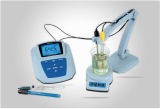
Ion Meter
10000 INR/Piece
Product Details:
- Usage Industrial
- Material Plastic
- Height 60 Millimeter (mm)
- Power Supply Electic
- Power Consumption 220 Volt (V)
- Weight 1.75 Kilograms (kg)
- Display Type Digital Only
- Click to view more
X
Ion Meter Price And Quantity
- 10000 INR/Piece
- 3 Piece
Ion Meter Product Specifications
- Ion Concentration-0 to 19999 ppm
- 188 Millimeter (mm)
- 220 Volt (V)
- Electic
- 60 Millimeter (mm)
- Plastic
- Digital Only
- 210 Millimeter (mm)
- Industrial
- 1.75 Kilograms (kg)
- White
Ion Meter Trade Information
- 3-4 Piece Per Day
- 3-4 Week
- All India
Product Description
An ion meter, also known as an ion-selective electrode (ISE) or ion-selective meter, is a device used to measure the concentration of specific ions in a solution. These ions can be either positively charged (cations) or negatively charged (anions). Ion meters are commonly used in various scientific, environmental, and industrial applications where precise measurements of ion concentrations are necessary.Ion Meter Specifications: pH Range: -2.000 to 16.OOO pH + degree centigrade,pH Accuracy: 0.002 pHORP Range: O to +1999.9mVORP Accuracy: plus minus 0.2 mVIon Concentration Range: 0 to 19999 ppmIon Concentration Accuracy: plus minus 0.5% F.S (Monovalent), +1% FS (Divalent)Temperature Range: 0.0 to 100.0 degree centigradeTemperature Accuracy: plus minus 0.3C,pH Calibration Points: 2 p o i n t s , N I S T ( p H 4 . 0 0 / 6.86 / 9.18 ) or USA ( pH 4.01 / 7.00 / 10.01 )Ion Calibration Points: 2 to 5 points, (10 /10 /10 /10 /10 /mol/L)Temperature Compensation: 0 to 100 degree centigrade, Manual or AutomaticBuilt-in Ion mode: N 3 a, Ag, K, NH, CL, F, Ca, No, Pb, I, Cu, Br, CN,Memory & Output: 99 data sets with date/time stamping, USBPower Requirements: DC 9V, using AC adapters, 220VAC, 50HzDimensions: 210 (L) mm X 188 (W) mm X 60 (H )mmWeight: 1.75kgHere are some key points about ion meters: 1. Ion-Selective Electrode (ISE): The core component of an ion meter is the ion-selective electrode. It is a specialized sensor that responds selectively to a particular ion in the solution. There are different types of ion-selective electrodes designed for specific ions, such as hydrogen ions (pH), sodium ions, potassium ions, chloride ions, etc.2. Reference Electrode: In addition to the ion-selective electrode, ion meters also include a reference electrode. The reference electrode provides a stable and constant potential against which the ion-selective electrodes potential is measured.3. Calibration: Ion meters require calibration to ensure accurate measurements. This involves preparing standard solutions with known ion concentrations and adjusting the meter accordingly.4. pH Measurement: While not exclusively ion meters, devices that measure pH levels also fall into this category. pH meters use ion-selective electrodes to measure the concentration of hydrogen ions in a solution.Applications of Ion Meter: 1. Laboratory Analysis: Ion meters are widely used in laboratories for analyzing samples in fields such as chemistry, biochemistry, environmental science, and medicine.2. Water Quality Monitoring: Ion meters are employed to assess the concentration of specific ions in water, helping to determine water quality and potential environmental impacts.3. Industrial Processes: In industries like food and beverage, pharmaceuticals, and chemical manufacturing, ion meters are used to monitor and control processes where specific ion concentrations are critical.Ion Meter Features: 1. Ion concentration mode directly displays readings in ppm, ppt, or any other units of your choice2. Calibrate up to 2 points for pH using USA or NIST buffer sets; Up to 5 points for ion concentration measurement3. Auto-buffer recognition eliminates calibration mistakes and ensures calibration accuracy4. Automatic temperature compensation for best accuracy under fluctuating temperatures5. Meters automatically calculate and display electrode slope6. Automatic message prompts help your easy to operate meter7. Expanded memory stores and recalls up to 99 data sets8. USB Communication interface can be sent data to computer9. Meters Included: pH Electrode, pH Buffers, Temperature Probe, Electrode Stand, 9V Power AdapterFAQs of Ion Meter:
Q: What is the range of ion concentration measurement for the Ion Meter?
A: The Ion Meter can measure ion concentrations ranging from 0 to 19999 ppm.Q: What type of display does the Ion Meter have?
A: The Ion Meter features a digital-only display.Q: What is the power supply requirement for the Ion Meter?
A: The Ion Meter operates on an electric power supply with a power consumption of 220 Volts (V).Q: What are the dimensions of the Ion Meter?
A: The Ion Meter has a length of 210 mm, a width of 188 mm, and a height of 60 mm.Q: What is the weight of the Ion Meter?
A: The Ion Meter weighs 1.75 kilograms (kg).Tell us about your requirement

Price:
Quantity
Select Unit
- 50
- 100
- 200
- 250
- 500
- 1000+
Additional detail
Mobile number
Email
 English
English Spanish
Spanish French
French German
German Italian
Italian Chinese (Simplified)
Chinese (Simplified) Japanese
Japanese Korean
Korean Arabic
Arabic Portuguese
Portuguese Get A Quote
Get A Quote 





